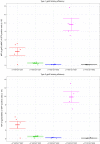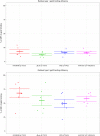HLA-DQ β 1 alleles associated with Epstein-Barr virus (EBV) infectivity and EBV gp42 binding to cells
- PMID: 28239644
- PMCID: PMC5313076
- DOI: 10.1172/jci.insight.85687
HLA-DQ β 1 alleles associated with Epstein-Barr virus (EBV) infectivity and EBV gp42 binding to cells
Abstract
Epstein-Barr virus (EBV) infects B cells and ~95% of adults are infected. EBV glycoprotein gp42 is essential for entry of virus into B cells. EBV gp42 binds to the β1 chain of HLA-DQ, -DR, and -DP on B cells, and uses these molecules for infection. To investigate if certain HLA-DQ alleles are associated with EBV seronegativity, we recruited ~3,300 healthy adult blood donors, identified 106 EBV-seronegative individuals, and randomly selected a control group of EBV-seropositive donors from the donor pool. A larger than expected proportion of EBV-seronegative subjects were HLA-DQ β1 *04/*05 and *06/*06, and to a lesser extent, *02/*03, compared with the control group, while a larger than expected portion of EBV-seropositive persons were HLA-DQ β1 *02/*02. We examined the ability of EBV gp42 to bind to different HLA-DQ molecules using human and mouse cells stably expressing these alleles. EBV gp42 bound less effectively to cells expressing HLA-DQ β1 *04/*05, *06/*06, or *03/*03 than to cells expressing HLA-DQ β1 *02/*02. These data are consistent with our observations of increased EBV seronegativity with DQ β1 *04/*05 or *06/*06 alleles. These findings emphasize the importance of a single genetic locus (HLA-DQ β1) to influence infectivity with EBV.
Conflict of interest statement
Conflict of interest: The authors have declared that no conflict of interest exists.
Figures









Similar articles
-
Membrane anchoring of Epstein-Barr virus gp42 inhibits fusion with B cells even with increased flexibility allowed by engineered spacers.mBio. 2015 Jan 6;6(1):e02285-14. doi: 10.1128/mBio.02285-14. mBio. 2015. PMID: 25564465 Free PMC article.
-
Coreceptor restriction within the HLA-DQ locus for Epstein-Barr virus infection.Proc Natl Acad Sci U S A. 2000 Aug 1;97(16):9252-7. doi: 10.1073/pnas.160171697. Proc Natl Acad Sci U S A. 2000. PMID: 10908662 Free PMC article.
-
Cleavage and secretion of Epstein-Barr virus glycoprotein 42 promote membrane fusion with B lymphocytes.J Virol. 2009 Jul;83(13):6664-72. doi: 10.1128/JVI.00195-09. Epub 2009 Apr 15. J Virol. 2009. PMID: 19369343 Free PMC article.
-
Structural and Mechanistic Insights into the Tropism of Epstein-Barr Virus.Mol Cells. 2016 Apr 30;39(4):286-91. doi: 10.14348/molcells.2016.0066. Epub 2016 Apr 6. Mol Cells. 2016. PMID: 27094060 Free PMC article. Review.
-
[The entry of Epstein-Barr virus into B lymphocytes and epithelial cells during infection].Bing Du Xue Bao. 2014 Jul;30(4):476-82. Bing Du Xue Bao. 2014. PMID: 25272606 Review. Chinese.
Cited by
-
CD4 T cells restricted to DRB1*15:01 recognize two Epstein-Barr virus glycoproteins capable of intracellular antigen presentation.Proc Natl Acad Sci U S A. 2024 Oct 29;121(44):e2416097121. doi: 10.1073/pnas.2416097121. Epub 2024 Oct 21. Proc Natl Acad Sci U S A. 2024. PMID: 39432795 Free PMC article.
-
Connecting the dots: Presentation of EBV antigens on HLA class II risk alleles connects the two main risk factors of multiple sclerosis.Proc Natl Acad Sci U S A. 2024 Dec 3;121(49):e2420070121. doi: 10.1073/pnas.2420070121. Epub 2024 Nov 25. Proc Natl Acad Sci U S A. 2024. PMID: 39585999 Free PMC article. No abstract available.
-
Human leukocyte antigen-DQA1*04:01 and rs2040406 variants are associated with elevated risk of childhood Burkitt lymphoma.Commun Biol. 2024 Jan 5;7(1):41. doi: 10.1038/s42003-023-05701-5. Commun Biol. 2024. PMID: 38182727 Free PMC article.
-
The impact of HLA polymorphism on herpesvirus infection and disease.Immunogenetics. 2023 Jun;75(3):231-247. doi: 10.1007/s00251-022-01288-z. Epub 2023 Jan 3. Immunogenetics. 2023. PMID: 36595060 Free PMC article. Review.
-
Association between Human Leukocyte Antigen (HLA) DQB1*06 and HLA DQB1*03 and adverse outcomes in a group of critically ill patients with COVID-19 in Tunisia: a cross-sectional study.Pan Afr Med J. 2023 Jun 27;45:109. doi: 10.11604/pamj.2023.45.109.39956. eCollection 2023. Pan Afr Med J. 2023. PMID: 37719057 Free PMC article.
References
-
- Longnecker R, Kieff E, Cohen JI. Epstein-Barr Virus. In: Knipe DM, et al., eds. Fields Virology. Philadelphia, PA: Lippincott Williams and Wilkins; 2013:1898–1959.
Publication types
MeSH terms
Substances
Grants and funding
LinkOut - more resources
Full Text Sources
Other Literature Sources
Research Materials

